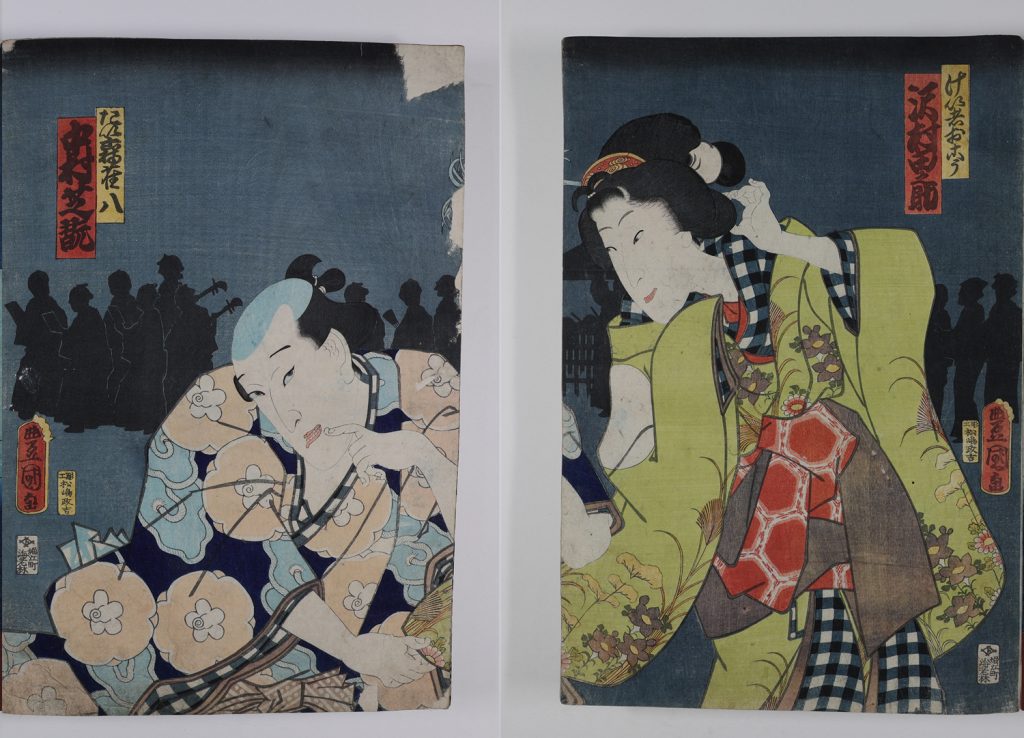Plates 31-32: Actors Sawamura Tanosuke III as the Geisha Okō and Nakamura Shikan IV as the Jester (Taikomochi) Jakuhachi
Plates 31-32: Actors Sawamura Tanosuke III as the Geisha Okō and Nakamura Shikan IV as the Jester (Taikomochi) Jakuhachi

Utagawa Kunisada I (Toyokuni III) 歌川 国貞 (1786-1865)
Actors Sawamura Tanosuke III as the Geisha Okō and Nakamura Shikan IV as the Jester (Taikomochi) Jakuhachi (1861)
Ink and mica on paper
Seals:
Publisher: Ebiya Rinnosuke
Censor: Unknown
Carver: Unknown
Artist: Unknown
In this work, audiences are presented a diptych actor print by Toyokuni III, here showing actors Sawamura Tanosuke III 三代目 沢 村田之助 (1845-1878) on the right in an onnagata 女形 (male kabuki actor who plays female parts) role and Nakamura Shikan IV 四代目中村芝翫 (1831-1899) as the jester on the left. The play depicted is the 1861 Tokkaidō Iroha Nikki (Iroha [ABCs] Diary of the Stations of the Eastern Road) at the Ichimura Theater in Edo. Both male and female characters, both played by male actors, are represented in the distinct Utagawa school style,1 characterized by their unique and more feminized facial expressions and nigao-e 似顔絵 (portrait) style, allowing individual actors to be easily recognizable in the prints. Within the Utagawa school, Toyokuni I strayed away from the style of many of his own contemporaries, instead taking a more caricature method in depicting kabuki actors, grasping the recognizable aspects as actors and their character tropes. He even published a guide on his style of representation, Yakusha awase kagami 役者相猊鏡 (A Mirror of Actors Compared), which was followed closely by each of his pupils, especially Toyokuni III, who would eventually head the school himself.
In making these characters more recognizable in their roles onstage, special attention must be paid to finer details and their implications on the subject of the work. This was particularly true of the male actors portraying female characters, as particular care was given to craft a unique and transformative ideal of femininity and beauty onstage for audiences.2 Such a feminine onnagata performance is seen here with male actor Sawamura Tanosuke III portraying a female geisha character in the right portion of the diptych. The main goal of these onnagata roles was to portray an almost surreal sense of beauty and grace, seen here in Tanosuke’s portrayal and further accentuated by Toyokuni’s representation. Unlike her male counterpart on the left of the print diptych, portrayed by Nakamura Shikan IV, the geisha sports a much more reserved expression, with a small smile as she peers slightly back over her shoulder at the much more confident looking man tugging at her clothing. Her colorful and intricately decorated sleeves obscure most of her arms, and her pose seems relaxed and natural. This detail in costuming was also intentional, as dramatic drapery would allow the costumes to ‘remodel’ their own bodies to a more female likeness.3 Through Toyokuni’s stylistic reimagination of the figure focusing on both anatomy and costume, audiences are able to interpret this ideal hyper-feminine and graceful onnagata performance as intended to be viewed onstage.
Mikayla Hernandez-Guevara
History of Art
Class of 2022
Annotated Bibliography
Herwig, Henk. “The Development of Facial Likeness in Kabuki Actor Prints.” Ukiyo-E art vol. 172 (2016): 84–102. https://doi.org/https://doi.org/10.34542/ukiyoeart.1726.
This article overviews the development of kabuki actor prints following their conception, specifically highlighting the differences in facial expressions and unique facial features that allowed audiences to identify individual actors instead of generic character types. For the Utagawa school specifically, Herwig focuses on the lineage’s more striking move away from traditional facial depictions.
Mezur, K. Beautiful Boys/Outlaw Bodies: Devising Kabuki Female-Likeness. Palgrave Macmillan, 2006.
This book offers a detailed analysis into female roles of kabuki characters, and how ideals of women were perpetuated on the theater stage. One section focuses specifically on prints made of another one of Tanosuke III’s female roles.
Mezur, Katherine. “The Kabuki Onnagata: A Feminist Analysis of the Onnagata Fiction of Female-Likeness,” Ph.D. diss., University of Hawaii Manoa, 1998.
Another analysis of female kabuki roles, this dissertation also focuses on kabuki theater and how ideals of feminine behavior and beauty were pushed to audiences through performance. It also looks at the social and gendered implications made in having young men play roles that influenced women’s behavior in their everyday lives.
